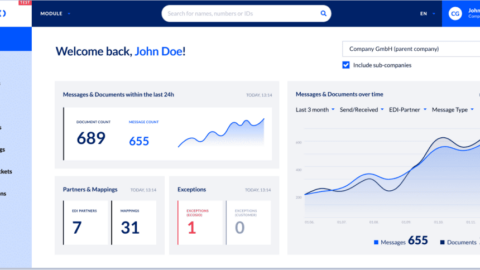Over the past decade there has been a clear and continual shift by supply chain businesses away from hosting business-critical software locally. Whether it’s multiple department systems or just a lone software instance, the vast majority of businesses have participated in cloud migration to some extent, with Accenture calculating the adoption of cloud technologies to have grown from 82% to 95% between 2019 and 2021 alone.
When you consider the benefits of moving B2B processes to the cloud, it’s not hard to see why so many companies are doing so. From a cost perspective, moving to the cloud reduces expenses relating to hardware and maintenance. Further, while security concerns are often cited as a key reason not to move to the cloud, cloud-based solutions typically offer a redundant infrastructure, making them much more reliable than locally-hosted systems. Most compelling of all, however, is the flexibility, scalability and resilience offered by the cloud, as processes and resources can be adapted quickly and easily as needs change. What’s more, cloud-based solutions also often offer better data visibility and are typically updated automatically.
What we have found
In line with recent trends, in our recent survey we found that the vast majority of respondents (65%) expect cloud-based EDI to become the norm in the future, with only 13% of those surveyed not expecting cloud migration to become more popular.
What can you do?
If you are still running your systems via locally-hosted software, it’s worth considering if moving to the cloud could improve efficiency, flexibility and resilience. While sticking with your current solution may seem like the easier choice, migration projects don’t have to be difficult or disruptive, and sticking with an outdated system will cost your business dearly in the long run. When assessing your options, it’s also important to consider all related costs. Many businesses wrongly assume that on-premise solutions are more cost-effective purely because they fail to properly calculate the total cost of ownership by ignoring key factors such as time and personnel costs.
“Companies with modern technology architectures outperform their competitors with better customer service, more efficient operations, and stronger customer advocacy.”
Questions to ask yourself
- Would increased system flexibility help you in achieving strategic goals moving forward?
- How confident are you that you can retain sufficient in-house expertise to keep internal systems running smoothly as your business grows/evolves?
- Do you currently operate a redundant infrastructure or are you at risk of catastrophic data loss?
- Are you aware of what modern cloud-based B2B integration solutions can deliver?
- Could cloud migration benefit your business?
Want more information on EDI trends?
This article is based on a section from our recent report on The Future of B2B Integration, in which we share survey results as well as predictions concerning the most significant B2B integration trends. To download your free copy now, simply visit the report download page and enter your details!












